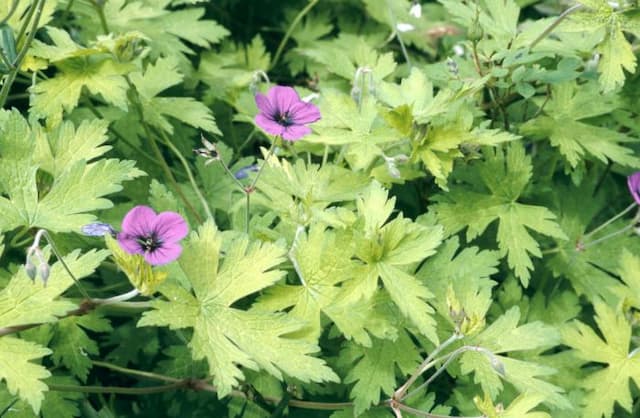Dusky Cranesbill Geranium phaeum 'Rose Madder'

ABOUT
The Geranium phaeum 'Rose Madder' is a flowering plant known for its intriguing dark maroon to deep purple blooms, which resemble the shape of a cranesbill. The petals of these flowers are gently rounded with faint veining that adds subtle detail and character. They are held atop long, slender stems that rise from the plant's lush green foliage. The foliage of 'Rose Madder' is another attractive aspect of the plant, with leaves that are deeply lobed and have a somewhat ruffled or serrated edge. This creates a textural contrast within the garden. The leaves can sometimes take on a slightly marbled appearance with lighter green markings that give them an ornamental quality even when the plant is not in bloom. Over the flowering season, 'Rose Madder' can produce an ample display of flowers that are capable of giving the plant a rich and alluring presence in the garden. It can serve as an excellent backdrop for other plants or as a standalone feature due to its decorative leaves and distinctive flowers.
About this plant
 Names
NamesFamily
Geraniaceae.
Synonyms
Mourning Widow, Dusky Crane's-bill, Mournful Widow.
Common names
Geranium phaeum 'Rose Madder'.
 Toxicity
ToxicityTo humans
The plant commonly known as Dusky Cranesbill is not considered toxic to humans. There are no known toxic effects from ingesting this plant, and it is not associated with any symptoms of poisoning.
To pets
Dusky Cranesbill is also considered non-toxic to pets. There are no significant reports of toxicity from ingestion of any part of this plant by pets such as cats or dogs. Owners can generally expect this plant not to cause harm if their pets happen to ingest it.
 Characteristics
CharacteristicsLife cycle
Perennials
Foliage type
Deciduous
Color of leaves
Green
Flower color
Purple
Height
2 feet (60 cm)
Spread
2 feet (60 cm)
Plant type
Herb
Hardiness zones
4
Native area
Europe
Benefits
 General Benefits
General Benefits- Attracts Pollinators: Geranium phaeum 'Rose Madder' is attractive to bees and other pollinating insects, encouraging biodiversity in your garden.
- Low Maintenance: This variety is known for being easy to care for, requiring minimal attention once established.
- Drought Tolerance: With its ability to withstand dry conditions, it is ideal for gardens in areas with less consistent rainfall.
- Long Blooming Period: It offers an extended flowering period from late spring to early summer, providing long-lasting visual appeal.
- Shade Tolerance: It can thrive in shaded or partially shaded areas where other plants might struggle to grow.
- Ground Cover: Its growth habit makes it a good plant for covering bare spots in the garden and suppressing weeds.
- Visual Impact: The unique deep red flowers of 'Rose Madder' add a striking color contrast in garden beds and borders.
- Deciduous Foliage: The leaves provide seasonal interest as they change color in the autumn before shedding.
- Wildlife Habitat: It offers shelter and breeding spots for insects, contributing to a healthy ecosystem in your garden.
- Cottage Garden Appeal: This plant is a classic choice for cottage-style gardens, complementing other traditional plants.
 Medical Properties
Medical PropertiesThis plant is not used for medical purposes.
 Air-purifying Qualities
Air-purifying QualitiesThis plant is not specifically known for air purifying qualities.
 Other Uses
Other Uses- Geranium phaeum 'Rose Madder' can be used as a natural dye for fabrics, yielding soft, violet hues due to the pigments present in the petals.
- The plant's leaves can add a decorative element to pressed flower art, complementing other pressed flowers with their intricate patterns and shapes.
- With their distinctive appearance, the flowers of this plant can provide inspiration for botanical illustrations and watercolor paintings.
- Dried petals from Geranium phaeum 'Rose Madder' can be incorporated into homemade potpourri mixes for a subtle, floral scent.
- The plant can be utilized in garden design and landscape architecture, serving as an ornamental ground cover that adds depth and contrast to flower beds.
- Geranium phaeum 'Rose Madder' can act as a living barometer; the flowers often close up when atmospheric pressure drops, indicating upcoming bad weather.
- The striking flowers can be used in culinary presentations, as an edible decoration on cakes and desserts, although they do not add much flavor.
- Parts of the plant can be incorporated into nature crafts, such as creating botanical bookmarks, greeting cards, or decorative wreaths.
- Garden photographers and artists may use the plant's unique beauty as a photogenic subject or a model for garden sculptures and installations.
- Geranium phaeum 'Rose Madder' is used as a companion plant in vegetable gardens to attract pollinators, thus aiding in the pollination of crops.
Interesting Facts
 Feng Shui
Feng ShuiThe plant Geranium is not used in Feng Shui practice.
 Zodiac Sign Compitability
Zodiac Sign CompitabilityThe plant Geranium is not used in astrology practice.
 Plant Symbolism
Plant Symbolism- Unexpected Meeting - Geraniums, in general, can symbolize an unexpected encounter or surprise, and the 'Rose Madder' with its distinctive deep blushing flowers, emphasizes this sense of surprise in its rich coloring.
- True Friendship - Geraniums often represent true friendship, and the long-lasting nature of the 'Rose Madder' reflects the enduring aspect of deep friendships.
- Good Health - Historically, geraniums have been planted and used for their health-giving properties, symbolizing a wish for good health to the receiver.
- Tranquility - The calming color of the 'Rose Madder' geranium denotes tranquility and the ability of the plant to bring peace to the mind and body.
- Favor and Gratitude - Giving someone a geranium can be a way of expressing thanks or showing favor, with the 'Rose Madder' adding a touch of elegance and passion to this gesture of appreciation.
 Water
WaterDusky cranesbill should be watered thoroughly when the top inch of the soil feels dry to the touch, which typically means watering once a week. It's important to water the plant deeply so that water reaches the root zone, encouraging deeper root growth. Apply approximately one gallon of water per plant each time you water, adjusting for rainfall and temperature, as the plant will need less water in cooler weather and more in heat. Overwatering should be avoided to prevent root rot.
 Light
LightDusky cranesbill thrives best in partial shade to full sun conditions where it receives indirect sunlight or morning sun with afternoon shade preferable. The ideal spot for planting is one that mimics its natural understory habitat, providing some shelter from the intense midday sun. It can also adapt to a variety of light conditions but too much direct sun can lead to leaf scorch, while too little will reduce flowering.
 Temperature
TemperatureDusky cranesbill can tolerate a range of temperatures and is hardy in zones 4 through 8. It can survive in temperatures as low as minus 30 degrees Fahrenheit, although it dies back to the ground in winter and returns in spring. The ideal temperature range for dusky cranesbill is between 60 to 75 degrees Fahrenheit during the growing season for optimal growth.
 Pruning
PruningPruning dusky cranesbill encourages healthy growth and prolific blooming. Deadhead spent blooms regularly to promote continuous flowering and cut back the entire plant after the first flush of flowers to rejuvenate the foliage. The best time for a more significant prune is late summer or after the first killing frost in autumn to remove old and faded leaves.
 Cleaning
CleaningAs needed
 Soil
SoilDusky Cranesbill prefers well-draining soil rich in organic matter with a neutral to slightly alkaline pH, ideally between 6.0 and 7.5. A mix of garden soil, compost, and perlite or sand can create an optimal environment for its roots.
 Repotting
RepottingDusky Cranesbill typically doesn't need frequent repotting and can be repotted every 2-3 years or when it outgrows its current pot, to refresh the soil and provide more space for growth.
 Humidity & Misting
Humidity & MistingDusky Cranesbill is adaptable to a wide range of humidity levels and thrives in average household humidity conditions without the need for added humidity.
 Suitable locations
Suitable locationsIndoor
Place in a well-lit room, water moderately; avoid wet feet.
Outdoor
Plant in partial shade, moist soil, protect from hot afternoon sun.
Hardiness zone
4-8 USDA
 Life cycle
Life cycleGeranium phaeum 'Rose Madder', commonly known as Dusky Cranesbill, begins its life as a seed that germinates in the spring when soil temperatures are suitable. The plant then enters a vegetative growth phase, producing a rosette of lobed leaves and establishing a strong root system. Over time, it develops into a hardy perennial that can reach heights of 60cm, with stems that can spread to form large clumps. From late spring to early summer, Dusky Cranesbill produces dark purple to maroon flowers with prominent veining, which are attractive to pollinators. After pollination, the plant sets seed in the form of a beak-like capsule, which disperses when mature, completing its reproductive cycle. During winter or unfavorable conditions, the plant dies back to the ground, relying on its perennial rootstock to resprout in the following growing season.
 Propogation
PropogationPropogation time
Spring-Early Summer
Geranium phaeum 'Rose Madder', commonly known as dusky cranesbill, is most effectively propagated through division. The best time for dividing this perennial plant is either in the spring or autumn. This is a simplified process where you carefully dig up the plant, ensuring to keep a good amount of soil around the roots, and gently tease or cut the root clump into smaller sections. Each section must have at least one shoot and a sufficient root system to ensure successful growth. Once divided, replant the sections at the same depth they were originally growing at and water thoroughly. The divisions should be spaced about 15 to 18 inches (38 to 45 centimeters) apart to allow ample room for growth. It’s important to keep the soil moist until the new plants are well-established.









